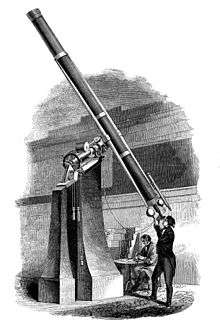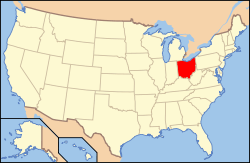Cincinnati Observatory
|
Original building atop Mt. Lookout | |||||||||||||||||||||||||||||||||||
| Observatory code |
765 | ||||||||||||||||||||||||||||||||||
|---|---|---|---|---|---|---|---|---|---|---|---|---|---|---|---|---|---|---|---|---|---|---|---|---|---|---|---|---|---|---|---|---|---|---|---|
| Location | Cincinnati, Ohio, US | ||||||||||||||||||||||||||||||||||
| Coordinates | 39°08′20″N 84°25′23″W / 39.139°N 84.423°W | ||||||||||||||||||||||||||||||||||
| Established | 1842 | ||||||||||||||||||||||||||||||||||
| Website | http://www.cincinnatiobservatory.org | ||||||||||||||||||||||||||||||||||
| Telescopes | |||||||||||||||||||||||||||||||||||
| |||||||||||||||||||||||||||||||||||
 Location of Cincinnati Observatory | |||||||||||||||||||||||||||||||||||
|
| |||||||||||||||||||||||||||||||||||
The Cincinnati Observatory is located in Cincinnati, Ohio (United States) on top of Hyde Park. It consists of two observatory buildings housing an 11-inch (28 cm) and 16 inch (41 cm) aperture refracting telescope. It is the oldest professional observatory in the United States.[3] It was a key facility for astronomical research and education at the University of Cincinnati and currently operates as a 19th-century observatory. There are regular viewings through both historical telescopes as well as tours and additional programs. The observatory also has an extensive outreach program, providing astronomical education for the Ohio/Kentucky/Indiana region.[4][5]
The Cincinnati Observatory is a contributing property to the Observatory Historic District.
History

Cincinnati Observatory was built by Ormsby M. Mitchel at the peak of Mount Ida,[7] a hill that overlooks downtown Cincinnati. Nicholas Longworth donated 4 acres (1.6 ha) of land for the purpose.[8] The Holy Cross Monastery and Chapel stands today at the site.[9] The cornerstone was laid on November 9, 1843, and presiding over the occasion was former President John Quincy Adams, with an introduction by Judge Jacob Burnet.[10] At 77 years old, it was to be his last public speech, and Mount Ida was renamed to Mount Adams in his honor.
In 1871, the Observatory came under the control of the University of Cincinnati and in 1873 it was transferred from Mt. Adams to Mt. Lookout in order to escape the smoke and dirt of the city, where it remains today.[11] The ground on which it stands was given to the city by John Kilgour in 1872.[12] A smaller structure, the Mitchel Building, holds the original telescope taken from the Mount Adams observatory. The 1873 building was built by the firm of Cincinnati architect Samuel Hannaford.[13] In 1998 the Observatory was declared a National Historic Landmark.
The asteroid 1373 Cincinnati was named to honor the staff of the observatory.
Instruments
- The 1845 Merz und Mahler 11 inch refractor – Housed in the "Mitchel Building". May be the oldest continually used telescope in the world. It is currently used for public education programs.
- The 1904 Alvan Clark & Sons 16 inch refractor – Housed in the "Herget Building". Used in public education programs and graduate research.
See also
References
- ↑ National Park Service (2007-01-23). "National Register Information System". National Register of Historic Places. National Park Service.
- ↑ "Cincinnati Observatory". National Historic Landmark summary listing. National Park Service. Archived from the original on 2008-01-19. Retrieved 2008-07-02.
- ↑ Felix Winternitz & Sacha DeVroomen Bellman (2007). Insiders' Guide to Cincinnati. Globe Pequot. p. 164. Retrieved 2013-05-08.
- ↑ "Cincinnati Observatory".
- ↑ "Cincinnati Observatory". Yelp. 13 September 2015.
- ↑ from "Smith's Illustrated Astronomy", 1848
- ↑ Charles Theodore Greve (1904). Centennial History of Cincinnati and Representative Citizens, Volume 1. Biographical Publishing Company. p. 713. Retrieved 2013-05-22.
- ↑ Charles Theodore Greve (1904). Centennial History of Cincinnati and Representative Citizens, Volume 1. Biographical Publishing Company. p. 898. Retrieved 2013-05-22.
- ↑ Rolfes, Steven (Oct 29, 2012). Cincinnati Landmarks. Arcadia Publishing. p. 50. Retrieved 2013-05-19.
- ↑ Charles Theodore Greve (1904). Centennial History of Cincinnati and Representative Citizens, Volume 1. Biographical Publishing Company. p. 899. Retrieved 2013-05-22.
- ↑ Grace, Kevin (Jan 4, 2012). Legendary Locals of Cincinnati. Arcadia Publishing. p. 12. Retrieved 2013-05-07.
- ↑ Charles Theodore Greve (1904). Centennial History of Cincinnati and Representative Citizens, Volume 1. Biographical Publishing Company. p. 896. Retrieved 2013-05-22.
- ↑ Federal Writers' Project (1943). Cincinnati, a Guide to the Queen City and Its Neighbors. p. 308. Retrieved 2013-05-04.
External links
| Wikimedia Commons has media related to Cincinnati Observatory. |
- Cincinnati Observatory Center
- View The Cincinnati Observatory Center in 3D
- Cincinnati Observatory Center Clear Sky Clock Forecasts of observing conditions.
- Merz und Mahler telescope photos



